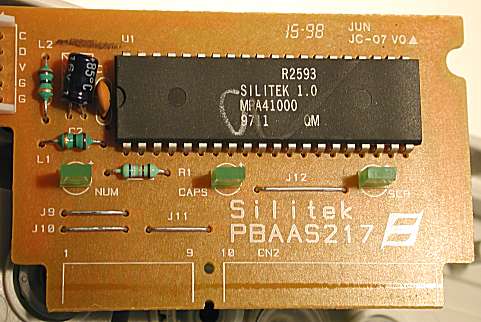[ The PC Guide | Systems and Components Reference Guide | Keyboards | Keyboard Construction and Operation | Other Regular Keyboard Components ]
Internal Keyboard Circuitry
The "brain" of the keyboard is the circuitry within the unit that handles the processing of keystrokes and exchanging information with the host system (the rest of the PC). While keyboards are fairly simple devices, you might be surprised at just how complex the internal circuitry is in a keyboard. In some ways it's like another whole computer in there...
In fact, the keyboard has within it small versions of several components you find within the PC as a whole. It has its own microprocessor, which "runs the show" so to speak. (This is of course a tiny CPU like the 8048, not a full-fledged CPU as the main PC hardware uses.) There is also some read-only memory (ROM) that runs this small processor, similar to the system BIOS code on the motherboard. Programmable keyboards also contain some EEPROM memory to hold programming information; this functions as if it were a tiny hard disk, in a way. Sort of. ;^)
|
Internal circuit board from a typical keyboard. The
chip is the |
This internal circuitry has two fundamental jobs. First, it is responsible for sensing the raw signals created by the keyswitches as they make electrical contact, and translating them into signals that can be sent to the PC. Due to the electrical characteristics of keystrokes, this is not as simple as it sounds. Second, it handles the actual interfacing between the keyboard and the rest of the PC system. The interface between the PC and the keyboard is a full bi-directional serial communications line, with its own special protocols and commands.
The operation of the internal keyboard circuitry is discussed in more detail in the section that describes the operation of the keyboard, including keypress detection and scan code generation, interfacing, and signaling.
![]() Next: Keyboard Cable
Next: Keyboard Cable
| The PC Guide
(http://www.PCGuide.com) Site Version: 2.2.0 - Version Date: April 17, 2001 © Copyright 1997-2004 Charles M. Kozierok. All Rights Reserved. |
Not responsible for any loss resulting from the use of this site. Please read the Site Guide before using this material. |
